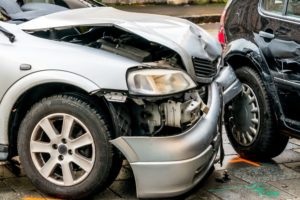Car Accident Scenarios. Who Is at Fault?
Personal InjuriesIt’s a question you might hear after a car accident: How did it happen? This is a critical question, as it concerns who may be at fault, and therefore financially liable, for your car accident.
The details of each car accident scenario matter. Each accident warrants a careful examination to determine fault. As a car accident attorney or insurance company reviews the details of your accident, they might consider who is typically liable in accidents like yours. By relying on experience with common car accident scenarios, your lawyer may work to determine who is responsible for your accident.
Some Common Car Accident Scenarios
The National Safety Council (NSC) looks at car accident scenarios from a big-picture perspective.
Research shows that car accidents do not always involve two motor vehicles but can instead involve:
- A motor vehicle and a pedestrian
- A motor vehicle and a fixed object (such as a sign, building, or fire hydrant)
- A motor vehicle and a bicycle
- No collision at all, as can be the case in a rollover accident
In these cases, a motorist may generally be liable. Unless a pedestrian or bicyclist does something negligent to cause the collision (such as darting suddenly into the road), the motor vehicle driver generally must avoid the collision. Even in these accident types, though, you may have a lawyer carefully examine the details of your accident. The attorney can determine fault beyond a doubt.
We will focus more specifically on multi-vehicle accidents, as these tend to be more common than other accident types. Some common car accident scenarios include:
Rear-End Collisions
The National Law Review explains that rear-end collisions often occur when one vehicle stops suddenly, and the trailing vehicle cannot stop, striking the rear end of the vehicle in front. These collisions can cause serious injuries, including but not limited to whiplash.
Who is liable for a rear-end collision?
The driver of the tailing vehicle is generally liable for a rear-end collision. Motorists should anticipate that the vehicle in front of them can stop suddenly and work to prevent a rear-end collision by:
- Maintaining a safe distance behind the vehicle in front of them.
- Considering how they might avoid a collision if the car in front stopped suddenly, whether by stopping, swerving, or engaging in another evasive maneuver
- Reducing speed when conditions like poor weather, construction, or rush hour increase the likelihood of traffic
- Keeping their brakes in good condition
There may be exceptions to this general rule. For example, if a motor vehicle driver stops without reason, they can be liable for a resulting rear-end collision.
Side-Impact Collisions
Side-impact collisions occur when one vehicle strikes another from the side, whether in a T-formation or at a different angle.
Who is liable for a side-impact collision?
This depends on the details of how the collision happened. In many cases, the vehicle that strikes the other is liable for the collision. A side-impact collision may happen when:
- A motorist runs a red light or stops sign, hitting another vehicle already occupying an intersection.
- A motorist fails to recognize or abide by a yield sign.
- A motorist turns right without checking for oncoming traffic (in which case the motorist making the illegal turn should be liable)
- A motorist changes lanes or crosses traffic without necessary clearance.
Unlike rear-end collisions, the details and dynamics of side-impact collisions can vary greatly. An attorney can review evidence, including video footage and the police report from your accident, to determine fault.
Head-On Collisions
The Federal Highway Administration (FHWA) explains that head-on collisions are the most dangerous accident you can have. Even when two vehicles only glance against each other in a head-on manner, the impact can be severe enough to cause life-altering injuries.
Who is liable for a head-on collision?
This is not always immediately clear. When vehicles strike head-on, it is a given that one of the motorists did something wrong or that a significant vehicle defect resulted in the collision.
In some cases, the fault is apparent. For example, a motorist driving in the wrong direction on a one-way street is liable for a resulting accident. The same is true when a motorist drifts or pulls into oncoming traffic on a two-way street.
However, other head-on collisions are less cut-and-dry. For example, motorists can collide head-on as they pull into a turn lane in the middle of a two-way street. These turn lanes are for both motorists turning left and those turning right, and it is not always clear where someone should enter the turn lane (or who has the right of way).
As is the case for every accident type, insurance companies, police officers, and attorneys will determine fault. You can hire an attorney to make the case that another party is at fault, especially if you believe that one or more insurers have reached the wrong conclusion.
Rollover Accidents
Rollover accidents can be the fault of motorists who lose control of their vehicles because of their own carelessness. However, rollover accidents can also occur because a motorist is put in a dangerous situation and must swerve to avoid a collision.
Who is liable for a rollover accident?
It depends. You might hold the motorist driving the vehicle that rolled over responsible if the collision resulted from:
- Speeding
- Drunk driving
- A dangerous turn
- A vehicle defect that they are responsible for, such as an underinflated or overinflated tire
- Some other act or factor within their control
When a vehicle rolls over, it may cause other vehicles to strike the vehicle, strike other vehicles, or strike fixed objects near a roadway. The motorist who caused their own vehicle to roll over may be liable for these subsequent accidents.
However, the motorist in the vehicle that rolled over is not always liable. Say that a motorist is driving the speed limit when suddenly another driver pulls into traffic from an adjacent street right in front of the vehicle. The motorist of the first vehicle may swerve to avoid the collision, and their vehicle may roll over in the process. In this case, the driver who pulled dangerously into traffic will likely be at fault for the rollover accident.
Chain-Reaction Collisions
Chain-reaction collisions describe any event where one accident causes subsequent accidents. This often occurs in rear-end collisions. One vehicle stops suddenly, the trailing vehicle strikes it, and then another trailing vehicle strikes the rear end of the first trailing vehicle, and so on.
There are many other examples of chain-reaction collisions. One motorist may swerve out of their lane to avoid two vehicles that have already collided, and the motorist may strike another vehicle already occupying the lane they swerve into.
Whenever one accident leads to another, you have a chain-reaction collision.
Who is liable for a chain-reaction collision?
Determining fault for chain-reaction collisions is especially complicated. You may need to evaluate each individual collision, identifying who is most responsible for the accident.
Let’s take a multi-car to rear-end collision. Any motorist whose car strikes the rear of another vehicle may be liable. Every motorist who strikes the rear of another vehicle has seemingly failed to maintain a safe distance and, therefore, may be at fault for the resulting accident.
As another example, consider what happens when items fall off a truck into the roadway. Vehicles may strike the items or swerve to avoid the items, resulting in several accidents. Because no motorist can reasonably foresee items falling off a truck, the truck driver (and their employer) may be liable for all chain-reaction collisions caused by falling items.
Here’s the point: Every accident is unique. While the rear-ending driver is often liable for a collision, they are not always liable. An attorney can review the details of your accident and tell you, in their opinion, who is at fault for your collision.
Common Hazards That Lead to Car Accidents

The Insurance Information Institute (III) lists several behaviors that lead to fatal or injury-causing car accidents.
Dangerous driving behaviors that may make a motorist liable for accidents are:
- Speeding
- Driving while drunk
- Driving under the influence of drugs
- Texting while driving
- Talking on the phone while driving
- Eating food or drinking a beverage while driving
- Changing lanes without checking blind spots
- Running stop signs, red lights, and yield signs
- Driving too fast for present road conditions
- Failing to ensure a safe vehicle before driving
Many other acts and failures can increase the risk of a car accident. When assessing your accident to determine fault, a lawyer will look for any behaviors that caused or contributed to the collision.
How to Determine Fault for a Given Car Accident
You may already know who is at fault for your accident, or you may not.
In either case, it is in your interests to prove fault, and you may do so by:
- Getting the police report for your accident: On a police report, a law enforcement official may state explicitly or imply who they believe caused the accident. This is one piece of evidence that can help prove fault for your collision.
- Seeking video footage of the accident: Some accidents become a case of he-said, she-said. Video footage does not lie and can prove decisively who is at fault for a car accident.
- Getting witness accounts: Witnesses to car accidents generally have no reason to lie. Therefore, their accounts of an accident can be compelling evidence of fault.
An attorney can take these steps for you. Your lawyer may also take other steps to prove fault, like hiring experts to reconstruct your accident.
I Was in a Car Accident. What Should I Do Now?
A car accident victim’s health should be the greatest priority.
With this in mind, you may:
- Seek medical attention, especially if you have not received a formal diagnosis for accident-related injuries
- Return to the doctor to check on any injuries you have already received a diagnosis for
- Keep all records of treatment and medical bills
- Keep a journal about your injuries and related pain
You may also hire a lawyer to handle the financial aspects of your case. You may need to file an insurance claim or may even choose to pursue a lawsuit against at-fault parties. An attorney can handle either of these processes so that you can focus on your recovery.
How an Attorney Can Help After a Car Accident
A car accident lawyer will have ample experience helping car accident victims. You might do research into injury firms serving your geographic region. Take advantage of free consultations, which are no-cost phone calls with law firms that may want to represent you after a car accident.
A car accident lawyer may handle every step of your insurance claim or lawsuit, including:
- Investigation of the accident
- Determination of liability
- Documentation of your damages
- Compilation of care-related paperwork
- Calculation of the cost of your damages
- Hiring experts
- Negotiating a settlement
- Taking your case to court
Your attorney of choice should keep you informed as your case moves forward. They should run any settlement offers by you and explain whether they believe the offer is fair (or not).
Can I Afford an Attorney After a Car Accident?
Yes. Ethical car accident attorneys work for contingency fees. This means that they charge no upfront fee and only receive a portion of the financial recovery they get for you. If the attorney does not secure compensation for you, you will owe them nothing.
Therefore, every car accident victim can afford to hire a lawyer. Considering that you may be struggling with injuries and deserving substantial compensation, letting a lawyer lead your case is in your interest.
Call a Personal Injury Today for a Free Consultation
Do not wait to start your search for a car accident attorney. The civil code in your state may require your lawyer to file your case within a certain timeframe, and your lawyer cannot start the legal process until you hire them.
Call attorneys in your area today to complete free consultations and choose the right firm for you.
Nathan Hughey, an attorney and fourth-generation South Carolinian, founded Hughey Law Firm in 2007. Before that, he spent five years defending nursing homes and insurance companies. Leveraging his experience, he now advocates for those injured or wronged by such entities, securing over $220 million in verdicts and settlements.
